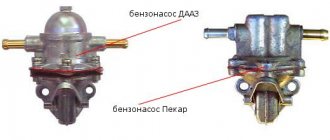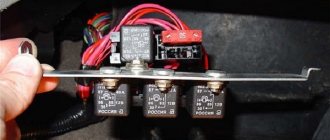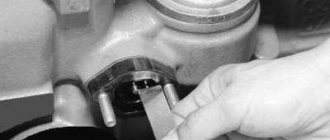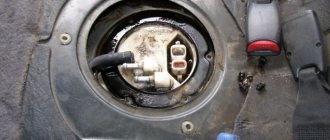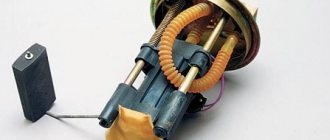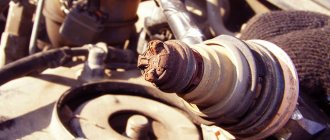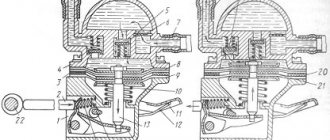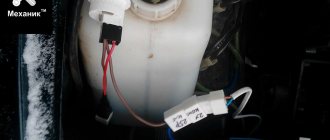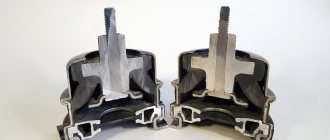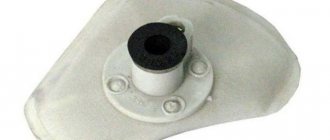Before we begin, it is necessary to make a small digression. No one can deny the fact that the fuel pump in a car’s design is one of the most important elements. Without which the car will not function, and malfunctions will lead to unstable engine operation.
It is worth noting that gasoline pumps can be divided into mechanical and electric. However, this article will not discuss mechanical fuel pumps due to the fact that they were used on older cars and cannot be found in modern cars.
How does an electric fuel pump work?
In the Photo: submersible fuel pump with a disassembled glass
Operating a car fuel pump
As we have already found out, a gas pump is a simple and unpretentious device. However, due to its compact size and high load, the pump requires special conditions for its operation. Firstly, its durability depends on the quality of the fuel, or more precisely on its cleanliness and the performance of the filtering system. Therefore, refueling with dirty, poor quality or contaminated fuel should not be allowed. Any specks of dust or particles can affect the integrity of the mechanisms.
To do this, it is necessary to regularly inspect fuel filters and screens that do not allow foreign elements to pass through. In addition, modern cars use submersible pumps, which are located directly inside the tank and are cooled by the fuel itself. Therefore, it is unacceptable to operate the car on an empty tank; overheating will certainly cause pump failure.
Symptoms of malfunction
Firstly, failure to comply with the rules for cleanliness, quality and availability of fuel in the tank will lead to pump failure, but other malfunctions associated with the fuel pump may also occur. But first, you need to understand the symptoms that will indicate a fuel pump failure.
First of all, you should pay attention to the unstable operation of the motor. The reason for this may be insufficient pressure in the fuel system due to the pump. At the same time, the car may gradually lose power or drive sharply, either normally or not at all.
Another sign of a malfunction or imminent breakdown of the fuel pump is the appearance of noise in the rear of the car. Strong buzzing sound from the fuel pump. Especially when you turn on the ignition, this is the first signal to replace it. Moreover, if you didn’t even pay attention to his work before.
In the Photo: The process of replacing a submersible fuel pump
Another sign of unstable operation is problems starting the engine. However, in such a situation there can be many reasons. From problems with the wiring of the entire car, to a malfunction of the motor itself or the electronic part of the control unit.
And the main sign of a malfunction is the complete inability to start the car, and complete silence in the fuel tank area when the ignition is turned on and attempts to start the engine.
How to find a breakdown
To start troubleshooting, you will have to know the entire structure of the fuel system. After all, a breakdown can occur not only in the fuel pump, but also in other elements of the fuel system. The entire fuel supply circuit consists of: a fuel tank with a fuel pump, fuel carrying pipes and hose, a fuel filter, injectors or other injection system and a return circuit of the fuel system.
If there is a suspicion of a drop in pressure in the fuel system, then the malfunction could occur in one of these elements. Next we will briefly go through each of them.
Fuel tank
In most modern cars, the fuel tank is a sealed container with a pressure release valve. However, the pressure in the tank is maintained and helps the entire system operate. But there are cases when the valve in the tank cap stops functioning normally and pressure disappears in the fuel tank or excess pressure accumulates. In this case, the entire system may not work correctly.
In addition, the tank may leak due to damage or corrosion. In this case, in addition to increased consumption and loss of pressure in the tank, there is a high probability of fire.
Fuel pump malfunction
The device itself can fail for a number of reasons:
• The gasoline pump has already exhausted its service life and the membrane with all its elements is not capable of pumping the required amount of fuel and maintaining the nominal pressure in the system.
• The valve responsible for maintaining constant pressure in the fuel system has failed and is constantly leaking fuel. Because of this, the engine does not receive enough gasoline and power decreases.
• The clogged mesh at the inlet to the fuel pump has become very dirty and has stopped passing a sufficient amount of fuel. In this case, in addition to reducing engine power, the fuel pump itself begins to work with increased load, which leads to rapid breakdown.
In the Photo: Filter mesh clogged with various dirt
• Also, the electrical wiring to the fuel pump may be damaged, or the contacts on the terminals of the device itself may be oxidized. But first of all, you should check the fuse in the cabin unit. If you successfully replaced the fuse with a new one, and it burned out again, you will have to carefully check the electrical wiring.
Symptoms of a faulty fuel pump
Fuel pump for VAZ
Actually, these are rather two stages of the same malfunction, although it happens that malfunctions in the operation of the fuel pump do not lead to its complete failure. Especially when these failures are caused by some extraneous factors. And so, the fuel pump either simply fails or does not work at all. These are all his breakdowns. Another thing is that there are many breakdowns of other elements, which in their symptoms are very similar to fuel pump breakdowns.
As for the signs of a fuel pump malfunction, there can be a lot of them, and as already mentioned, they may coincide with symptoms of problems in other components and systems of the car. Therefore, we will describe only the most common and most characteristic of these symptoms.
- the car does not start or stalls frequently;
- engine troits;
- extraneous noise in engine operation;
- drop in engine power;
- absence of characteristic noise when the fuel pump operates;
The signs are very eloquent, but it’s not always possible to understand what they are talking about. And here we cannot do without methods for diagnosing the fuel pump.
Gasoline supply problems - common symptoms
Malfunctions of the fuel supply system are conventionally divided into 2 categories:
- The combustible mixture is not supplied to the cylinders at all.
- Gasoline is supplied intermittently or under insufficient pressure.
In the first case, the engine does not start and does not engage the starter during rotation, that is, it does not show signs of life. In such a situation, it is always easier to determine the cause of the breakdown.
When insufficient fuel enters the cylinders, the following symptoms appear:
- starting the power unit “from cold” is very difficult, the engine seizes and “sneezes”, it starts in 3–10 attempts;
- idling is unstable, the engine “troubles”;
- dynamic acceleration becomes impossible - a sharp opening of the throttle causes a long dip and deceleration;
- when the driver releases the accelerator pedal, the engine often stalls;
- The car has difficulty climbing hills and accelerates slowly when fully loaded.
The cause of the above phenomena may be a malfunction of the fuel pump or other elements of the system, and the primary symptoms are almost the same. To carry out an accurate diagnosis, you need to understand how the car's power system works.
How to determine if a fuel pump is faulty
Be that as it may, most of the signs indicating a fuel pump malfunction may indicate problems in other systems and components of the machine. The car is malfunctioning - maybe the spark plugs, maybe the ignition, maybe some sensor is acting up. Extraneous noise in the engine can generally be caused by various breakdowns. Even when the engine stalls immediately after starting, you cannot blame only the fuel pump. For example, without readings from the crankshaft position sensor, the ECU can stop the pump, which is quite a normal car reaction to such a problem. And even a decrease in pressure in the system can be caused by leaks in the fuel lines, breakdown of the bypass valve and other failures.
Similar symptoms not related to the fuel pump
The symptoms that appear due to a lack of fuel in the supply line are quite typical and are very similar to problems with other systems. How to eliminate possible problems using the elimination method:
- Unscrew and inspect the spark plug skirts. When there is not enough fuel, the electrodes remain clean or become covered with a white coating. This is further evidence of a malfunction in the power system.
- Replace spark plugs. If they wear out, they create a similar effect - failures, difficult starting, and a drop in engine power.
- Check the functionality of the throttle position sensor (TPS) and idle air control.
- Measure the compression in all engine cylinders. Due to excessive wear, the naturally aspirated engine is unable to create the required pressure and vacuum; the mixture burns poorly, which is why identical symptoms occur.
Preventing fuel pump malfunctions
What should you pay attention to so that the fuel pump runs as long as possible? First of all, this is the quality of the fuel and, of course, timely replacement of the fuel filter. If the gasoline you fill contains various foreign inclusions, this will most likely negatively affect the condition and service life of the fuel pump, and not only it. Therefore, it is not worth saving on the quality of fuel, since such savings then result in very significant expenses for car repairs.
Monitor the fuel level in the tank. The fact is that the fuel pump is cooled by the same gasoline that it pumps. Accordingly, if there is little fuel, or the pump runs idle, it may overheat and therefore fail. Knowledgeable people also advise cleaning the gas tank at the appropriate time and not neglecting this procedure. This is, perhaps, all the prevention of problems with the fuel pump.
Diagnosis of faults in the VAZ 2110 fuel pump and its replacement
Before you start replacing the fuel pump, you need to make sure that it is broken. The VAZ electric fuel pump is checked in several ways:
- checking for mechanical damage - if the mechanism is significantly worn or debris or foreign particles get into it, the operation of the pump will be accompanied by a characteristic noise;
- checking the coarse filter for clogging - engine power drops, unstable operation at low and idle speeds, engine starting is difficult, etc.
- checking the pressure level in the fuel line - if in transition mode the pump does not produce the required pressure, it means that the coarse filter mesh is clogged, but if, when the return pipe is pinched, the pressure in the fuel line does not reach 0.4 kPa, the fuel pump itself is badly worn.
Please note that at idle speed the pressure value should be in the range of 0.23-0.25 kPa, when starting the engine the pressure value should reach 0.3 kPa, in transition mode the pressure readings should be in the range of 0.28-0.3 kPa. A pressure gauge is used for measurements.
If we consider the 2110 fuel pump, the price, as well as repair of the device, is quite affordable. At the same time, the VAZ 2110 electric fuel pump is usually not repaired, but only inspected (for example, replacing the fuel pump filter), since the pump itself is equipped with a non-demountable housing.
Of course, if necessary, electric fuel pumps are also repaired (repairing brushes and engine commutator, replacing the clutch, rewinding the armature) by experienced specialists, subject to the availability of special equipment. However, the cost of repair will be similar to the cost of a new pump, and sometimes higher.
For this reason, in the event of a breakdown, the pump is immediately replaced with a new one. The price of a VAZ electric pump will depend on the design, configuration and manufacturer. For example, an electric fuel pump 2112-1139009 VAZ-2110 submersible assembly (fuel drain line) PEKAR can be found for 2000-2200 rubles.
Now let's move on to the replacement. Preparatory work before replacing the fuel pump:
- prepare tools and materials (screwdriver, socket wrench “10”, wrench, open-end wrench “13”, rags, new pump);
- disconnect the battery terminal to prevent damage to electrical equipment and improve safety.
We also recommend reading the article about where the water in the gas tank comes from and what a gas tank moisture displacer is. From this article you will learn where the water in the fuel tank comes from, as well as how and how to remove water from the gas tank.
As for how to change the VAZ 2110 fuel pump, replacing the VAZ 2110 fuel pump and the general algorithm of actions are as follows:
- dismantle the seat to gain access to the fuel pump (unscrew the hatch located under the trim and disconnect the electric drive connector);
- Unscrew the tip of the fuel pipes with an open-end wrench, and, pulling the pipes, use a spanner to unscrew the eight nuts around the perimeter of the pressure ring to release the flange;
- remove the gasket under the pressure ring of the VAZ 2110 pump (the gasket is changed along with the pump);
Lift the fuel pump together with the float, not forgetting to place a rag in the interior to collect gasoline flowing from the body (the remaining gasoline in the pump is about 1 liter). - Reassemble in the reverse order; the correct position of the pump should correspond to the arrow directed towards the trunk (the arrow is located on the top of the lid).
During replacement, you must be careful, do not allow excessive fuel to leak into the cabin, work only with open windows for normal ventilation, etc. Also, when replacing, it is necessary to remove the level sensor and float. When installing a new pump, you need to make sure that the fuel lines are securely fixed, the same can be said about the electrical connectors.
Video on the topic
The fuel pump is one of the main components of a car. Without it, it is simply impossible to start the engine, much less operate it. Therefore, if you have any problems starting or operating the engine, you first need to check the fuel pump. To find out how to check a gas pump, you must first determine the basic principles of operation of this unit and possible breakdowns. As a rule, the fuel pump is not repaired and is replaced by a working one. However, it is necessary to identify that this is where the problem lies.
Features of the injection power system
The tasks of fuel pumps in carburetor and injection engines are slightly different. While in a carburettor engine it is important to deliver gasoline to the carburetor, in the case of an injection system this is not enough. The gasoline pump must not only pump fuel from the reservoir into the ramp, but also to obtain specific pressure, without which the engine simply does not move.
Access to the petrol pump in injection cars is also difficult because in the latest cars it is installed with the fuel cable and particulate filter directly in the fuel tank. This complicates the diagnosis, repair and maintenance of the entire fuel module, but simplifies the pump design since the gasoline itself is lubricated and cooled. But this often leads to devices.
The principle of operation of the fuel pump
Schematic diagram of a fuel pump
The main function of a fuel pump is to transfer fuel from the tank to the engine. In injection engines, the fuel pump is connected to the fuel rail, and in carburetor engines - to the carburetor. In this case, it is necessary not only to pump fuel, but also to provide a certain pressure. Too high pressure leads to increased richness of the mixture and high fuel consumption. Too low pressure leads to a lean mixture and a drop in power. Both the first and second cases negatively affect the engine life. That is, the fact that the gas pump pumps fuel does not indicate its full serviceability.
Design and operation of fuel supply
The system that provides the engine with the required amount of gasoline operates according to the following algorithm:
- After turning on the ignition, the electric fuel pump starts, raising the pressure in the line after itself to a certain level. The electrical power supply circuit of the unit is protected by a fuse.
- The fuel pressure regulator (common abbreviation - RDT) is located on the line after the pump and limits the upper pressure threshold, dumping excess fuel back into the tank through a separate pipeline.
- When the crankshaft is rotated by the starter and the engine continues to operate, fuel enters the fuel rail, mixes with air and is directed to the injectors built into each cylinder. The amount of mixture supplied to the combustion chambers is controlled by an electronic unit.
- On the way to the fuel rail, gasoline goes through 2 stages of filtration. The first is a mesh installed in the tank on the suction pipe of the pump, the second is a fine filter on the gas supply line.
Reference. In various car models, 2 schemes are used for installing the RTD and laying the return pipeline - in the engine compartment or directly in the gas tank. In the first case, the standard fuel pressure in the system is 2.7...3.0 Bar, in the second - 3.8...4 Bar.
A common mistake made by ignorant car enthusiasts: if the combustible mixture does not enter the cylinders, then the fuel pump is definitely not working. Knowing the design of the fuel supply, we can assume other problems:
- the protective fuse in the electrical circuit has blown, the pump is in good working order, but does not receive power;
- the primary or secondary filter is clogged (sometimes both at once), fuel flows in small quantities or does not flow at all;
- the pressure regulator has become unusable, dumping the lion's share of the fuel back into the tank, the engine gets nothing;
- One or more injectors have failed.
To accurately determine the source of the problem, you need to check the operation of the electric fuel pump and other elements. It is not necessary to go to a service station - diagnostic work can be carried out in your own garage.
When should you check your fuel pump?
It is necessary to check all potentially faulty components one by one, and the fuel pump first.
Problems when starting and running the engine are not always associated with the fuel pump. Sometimes the signs of a fuel pump breakdown are the same as those of a faulty fuel pressure regulator , injectors or jets, spark plugs and high-voltage wiring. Even experienced specialists who know by heart all the signs of a “dying” pump cannot unambiguously determine the type and cause of the breakdown the first time, and it is necessary to check all potentially faulty components one by one. In this case, the fuel pump is usually checked first. In this case, there are two types of malfunction - the fuel pump does not work at all or does not produce the required pressure. In the first case, the malfunction can be recognized by ear, since it should start when the ignition is turned on. In the second case, you need to know how to check the pressure of the fuel pump. Here you need to use a special pressure gauge. We list the main symptoms of a fuel pump malfunction:
- the engine does not start;
- the engine is unstable;
- the engine lacks traction during sharp acceleration;
- The engine lacks traction at low speeds.
The gasoline pump does not pump: reasons
If the gasoline pressure becomes lower than possible and the pump stops functioning, then it is necessary to understand why the pump does not pump fuel. If there is no hum in the fuel pump, i.e. it does not turn on when the ignition is turned on:
- You need to check the 12 Volt power supply, as well as the ground on the pump chip. If the relay does not work, then you need to install an electronic control unit “brains”. If there is no voltage, then the cause should be found and eliminated in the electrical circuit of the machine.
- Then, if there is voltage and ground, you need to check whether the wires in the fuel pump are damaged. To do this you need to remove it from the tank. On VAZ modules, the chip in the pump housing often burns out. Then you will need to replace the chip and the upper connector on the module body.
- If everything is fine here, but the motor does not work, then connect 12 volts from the battery to the module and also check the hum of the pump. If the pump does not function, this means that it is broken and the pump motor needs to be replaced.
And if the fuel pump is functioning, but does not pump fuel, then you need to check:
- Fuel pressure in the rail.
- Clogging of pipelines, fine and coarse filters.
- Fuel pressure stabilizer for functionality. It is located on the ramp or in the fuel pump module (in the tank).
- A frequent cause of breakdown is water in the tank, which turns into ice in winter, so the pump functions, but does not provide the necessary pressure.
The main causes of fuel pump failure
The coarse filter is clogged
Old and new fuel pump coarse filter
A clogged filter is brown in color because its cells are completely clogged with sediment.
The most common problem that causes the fuel pump to not pump is a clogged coarse filter. This filter is usually installed in the tank immediately before supply to the pump itself. This is where primary fuel filtration occurs. This malfunction can be determined visually. A clogged filter is brown in color; the cells in its mesh are almost completely clogged with sediment. Even a working pump cannot pump fuel through such a filter; as a result, the required pressure is not provided in the system. The coarse filter must be replaced. Its cost is low (about 50 rubles). However, replacing it takes time and a set of tools. First you need to remove the fuel pump itself, which is usually screwed to the tank. Before removing the fuel pump, you need to disconnect the terminal on the battery. Then the fuel pump is removed and the filter is removed from it. The filter itself is installed on the pump manually, without tools. It is recommended to change the coarse filter every 20 thousand. However, it can become clogged much faster. This depends on the quality of the fuel and the condition of the fuel tank. It only takes one refuel with low-quality fuel at an untested gas station to clog the filter. It can also easily become clogged with rust if the tank is already old and susceptible to corrosion.
How to check the functionality of the pump?
If the engine is absolutely “dead”, follow this algorithm:
- Turn on the ignition without turning the starter. A working electric fuel pump should respond with a quiet but distinct buzzing sound coming from the rear row of seats. If there is no sound, go to the next step.
- Using the car's operating instructions, find the number of the fuse that protects the pump's power circuit. Try replacing it; if unsuccessful, check the wiring and clean the contacts from oxides.
- If previous manipulations did not produce results, you need to measure the fuel pressure in the fuel rail.
Pressure measurement is also practiced when identifying symptoms of insufficient fuel supplied to the cylinders of the power unit.
To take measurements and compare signs of a breakdown with a fuel pump or other element, you need to reset the initial fuel pressure in the system, no matter how low it turns out to be.
If the pressure is below normal, proceed to find out the reasons according to the recommendations:
- There are pressure surges in the range of 0.2...0.3 Bar at idle - look for a problem in the filters. Surely the coarse mesh or secondary element is clogged.
- Use pliers to pinch the return line hose coming out of the RTD. The gasoline pressure should increase to 5 Bar, with the new pump - to 6 Bar. If the readings are 4 Bar or lower, the cause should be sought in the regulator or the pumping unit itself.
- The best way to identify a fuel pump malfunction is to exclude other parts of the system and take a measurement directly at the outlet fitting. If the pressure gauge shows 5 Bar, the unit is working properly and you need to change the RTD, which dumps half of the fuel into the tank.
To measure the pressure at the outlet of the electric fuel pump, you will need to remove the rear seat, dismantle the service hatch and connect a pressure gauge to the supply fitting of the unit. Here you may need adapters in the form of plastic clamps or threaded tubes.
Before changing the pressure regulator, make sure that the gas lines and filters are of normal capacity. Due to refueling with low-quality fuel, even the flow area of 8–10 mm tubes can become clogged. Then the pressure gauge on the ramp and pump will show different values, and the RTD will regularly drain excess fuel into the tank.
Let's sum it up
Taking into account the above information, it becomes clear that the uninterrupted operation of the electric fuel pump of the VAZ 2110 or any other car will depend on correct and timely preventive maintenance, as well as on careful operation and compliance with certain rules.
Finally, we note that in the event of malfunctions in the operation of the internal combustion engine, it is quite possible to diagnose and replace the fuel pump yourself in a regular garage (if you have the tools). However, working with the fuel system will require increased caution and compliance with all safety measures. If you are not confident in your abilities, it is better to turn to experienced specialists.
Source

